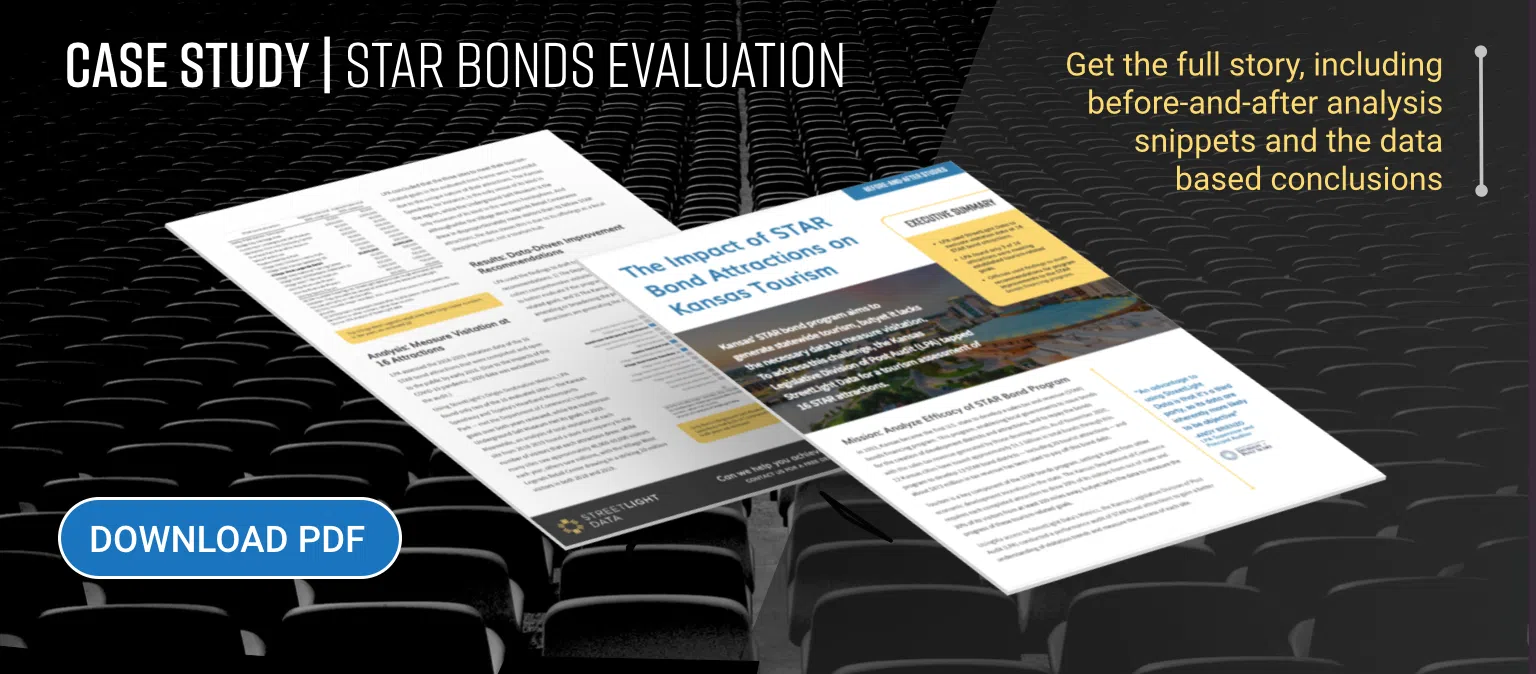Push PLAY to begin podcast:
Podcast: STAR Bonds Financing Program Evaluation
In August 2021, the Kansas Legislative Division of Post Audit (LPA) released an economic development incentive evaluation of the state’s sales tax and revenue (STAR) Bond financing program, an initiative that finances select state attractions with the intention of bringing tourism-related spending to the Kansas economy.
Since 1993, these bonds have unlocked more than $1 billion in economic development financing—but could they have done more? To get a deeper understanding of the impact STAR bond attractions have on state tourism, LPA worked with StreetLight Data to conduct a performance audit of visitation data at 16 sites.
In this episode of The Rundown, a podcast that offers discussion and analysis of LPA’s performance audits, we hear a step-by-step breakdown of LPA’s decision to audit the STAR Bond program, including the obstacles that stood in LPA’s way and the solutions brought forth by StreetLight Data.
Would you rather read than listen? The following is a preview of commentary from Andy Brienzo, LPA principal auditor who supervised the audit, and Dr. Daria Milakhina, LPA audit methodologist. They were interviewed by LPA’s Brad Hoff, host of The Rundown podcast.
The Challenge
“So, the state law establishing this program doesn’t include any requirements related to tourism… But Commerce has established a couple of tourism related goals for proposed STAR bond attractions. When they’re reviewing a proposed attraction, their guidance says that each attraction should draw 20% of visitors from outside Kansas and 30% of visitors from at least 100 miles away…but it didn’t collect sufficient or reliable data to evaluate whether attractions are meeting these goals.
We spent some time looking around and we settled on a company called StreetLight, which estimates visitation to various areas in the United States using cell phone and vehicle GPS location data. They typically work with transportation agencies, but their data are statistically representative of the US and Canadian populations, and we thought they were sufficiently reliable for our analysis. The other advantage to using StreetLight Data is that it’s a third party. So, its data are inherently more likely to be objective than the data that STAR Bond attractions are self-reporting to Commerce.”
The Analysis
“We ended up evaluating 16 of the 20 STAR bond attractions. We looked at calendar years 2018 and 2019. We excluded 2020 due to the COVID-19 pandemic, which of course affected the tourism industry particularly badly. We also wanted to only include attractions that were complete and open to the public by early in the year 2018, so this left 16 attractions, as I said.
Now of those 16 attractions, only three, according to the Streetlight Data, met both of Commerce’s goals in one or both years we reviewed. The Kansas Speedway and Topeka’s Heartland Park met both goals in both years and the Hutchinson Underground Salt Museum met both goals in 2019 and one of the two goals in 2018…And I think what we can draw from this conclusion is that really it’s unique attractions that are most likely to meet Commerce’s goals…and we think they probably drew visitors from out of state and from far away because they’re not available in many other places.”
The Conclusion
“Our results suggest that really only a few attractions are generating the out-of-state tourism that we think legislators probably originally intended for this program. And although STAR Bond projects are likely benefiting their local communities in concrete ways, through things like job creation and capital investment and amenities that improve local quality of life and maybe bring in people from different areas, most of these attractions are not drawing in a lot of out of state visitors, which really significantly limits their ability to generate new revenue for the state. As a result, legislators and the Department of Commerce will have to consider the extent to which these are the right types of projects to finance using STAR bonds and the extent to which they’re willing to continue having them supported through this program.”


